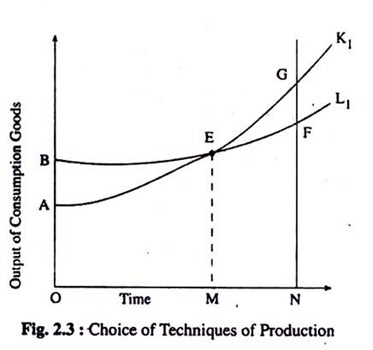The Conflict between Employment and Output!
In the choice of techniques, one encounters two kinds of conflict between objectives. First, the maximisation of employment involves a sacrifice of output.
Ultimately, this conflict boils down between present consumption and future consumption. The technique that maximises employment has a lower flow of current output.
How much investment need to be made—according to Amartya Sen and Maurice Dobb—depends on the time element or the planning horizon. If an importance is attached on raising the current consumption and employment rather than the future output, the labour-intensive techniques should be chosen. On the other hand, as capital-intensive techniques of production yield a lower volume of present employment and consumption, they promise higher future output growth, employment, and consumption.
ADVERTISEMENTS:
This argument can be explained in terms of Fig. 2.3. On the horizontal axis, time and on the vertical axis, output of consumption goods are measured.
Here AK1and BL1 curves show the flow of real consumption over time with two different techniques—the capital-intensive and the labour- intensive, respectively. The capital-intensive techniques represented by the curve AK1 shows lower present immediate output and a higher rate of growth than the labour-intensive techniques given by the BL1 curve.
Until we reach point E, the labour-intensive techniques yield higher output than the capital-intensive techniques. So the total gap ABE has to be made up by the capital-intensive techniques in the future time. As soon as the time period ON is reached, the above gap is met by the capital-intensive techniques (AEB = EFG). Following Amartya Sen, we may call the period OM, the ‘period of recovery’ which gives us the time period over which the aggregate consumption levels are the same. While selecting one technique over another, the recovery period is crucial.
ADVERTISEMENTS:
If we discover that this period is longer, i.e., if within the time horizon of our planning (may be 5 or 10 years), the amount of output we sacrifice to start with by adopting the more capital-intensive techniques is not recovered by the excess of output later on (i.e., after point M), the country should choose the labour-intensive technique.
Before we reach OM time period, the output of consumption of goods produced by the labour-intensive technology is larger. On the other hand, after OM, the capital-intensive technology is chosen as it will yield larger flow of consumption goods—a surplus of output of EFG will arise. The surplus as found in the long period may exceed the loss found in the short period. Thus, capital-intensive techniques of production should be chosen.
